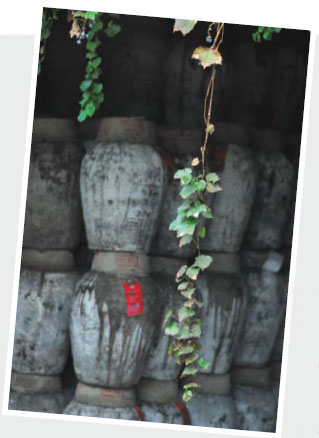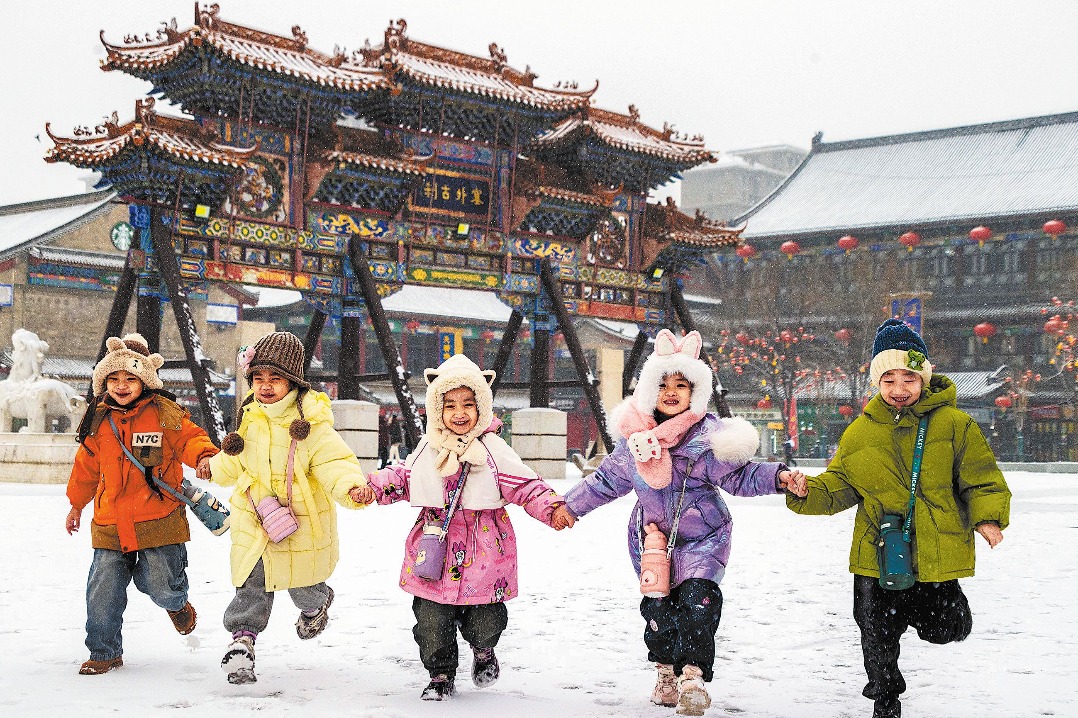Old man's brew tickles young

As China continues to modernize at a frantic pace, traditional rice wine offers a new generation a chance to slow down and enjoy life
David swipes his hand across the skyline of Shaoxing, Zhejiang province, as if to undo the cluster of high-rises that have shot up in the past 10 years.
"When I first came here, none of this existed. It was a sleepy town. Everything has changed dramatically."
Standing in the usually tranquil Meilong Lake Park, the Englishman's voice does battle with the gyrating guitar lines of an Australian psych-rock band whose performance at the inaugural Shaoxing MIDI festival has sent the crowd into raucous antics. Despite having lived in the eastern Zhejiang city for eight years, the Yorkshire native now finds himself in unfamiliar surroundings.
| Wu Hui's tasty rice wine infused nougat sits elegantly beside a cup of sweet rice wine. |
For Chinese people, Shaoxing is synonymous with the yellow rice wine locals have been producing since the Spring and Autumn Period (770-476 BC). Suitably, amid the food and beverage marquees lining the festival field is a rice wine cocktail booth. The amber nectar is never far from the action in this pocket of East China.
In fact, the very existence of the rock festival in downtown Shaoxing was catalyzed by the same authorities who have run the Shaoxing Rice Wine Festival for the past 22 years.
Historically, the weeklong festival is the harbinger of winter, which means the start of the brewing season. This year, the celebrations bear a more expansive complexion: Local industry heads have seen Shaoxing's GDP triple since 2011, and they hope to broaden the horizons of citizens and the reach of the city's dominant industry through youth-oriented rebranding.
"This is a good turnout," David says, pointing to a gang of well-dressed twenty-somethings. "It's nice to see different kinds of young people exploring the city."
The turnout was boosted by an unseasonably warm patch of November weather, but the bartender conjuring rice wine sangrias certainly helped. The Rice Wine Group organized the booth to show how modern flair can blend with tradition.
"They have 14 to 15 percent alcohol content and leave a nice taste in your mouth," a bartender says while preparing a rum-rice wine concoction. "Rice wine cocktails attract many young people during the festival."
That statement would certainly excite those involved in Shaoxing's most famous industry, who long to lose the old image and appeal to younger taste buds.
One such individual is Shaoxing native Bo Hong, vice-president of local brewing giant China Shaoxing Rice Wine Group. Bo is quietly passionate and swears by the health benefits of consuming a little Shaoxing spirit daily - he prefers the dry variety.
Despite producing an industry high 5 billion tons in 2015, Bo is cautious in his optimism, believing things need to slow down for the rice wine industry to fully flourish. It's a touching but somewhat paradoxical notion, given the helter-skelter nature of Shaoxing's development.
After strolling amid Shaoxing's rustic, monochrome buildings, it is easy to grasp the allure of Bo's point. From the hundreds of years spent producing some batches of rice wine, to the laid-back environment in which the drink is best enjoyed, the wine perfectly complements the meandering canals crisscrossing the city.
"The character of the wine is slow and mellow, exactly our marketing strategy for selling rice wine," Bo says.
But his relaxed tone masks the proactive steps his company is taking in marketing, research and product development. The challenge for his company's future is remaining relevant and appealing in a highly competitive marketplace.
Currently, Baijiu, China's ubiquitous spirit of choice, holds over 60 percent of the market in sales volume. Factor in the encroaching popularity of imported foreign alcohol - including wine, which saw 26.8 percent sales growth in 2015 - and the precarious position of rice wine becomes blindingly apparent.
| Hundreds of vats of aged rice wine pack the insides of warehouses on the outskirts of Shaoxing. Photos by Richard Whiddington / China daily |
One reaction has been the creation of rice wine alcopop drinks, fruity low-alcohol beverages sold online and in local shops. The inspiration stems from European companies that have rejuvenated their image through similar drinks that are 3 to 7 percent alcohol. One resonant example for Shaoxing companies to learn from is Jagermeister, a German liqueur established in the 1930s as a semi-medicinal hunter's brew that had an old man's reputation.
Another important avenue for rice wine is an improved online strategy. Online sales of tobacco and liquor products have increased by 13 percent since 2014. Rice wine companies need to develop a network of customers and offer an exciting interactive experience.
"If the rice wine industry doesn't harness the capabilities of the internet, it will lose out in the future," says Qiu Han, executive president of Zhejiang Modern E-commerce Business Research Institute.
Qiu is pragmatic in his assessment of rice wine companies and stresses the need to modernize not simply by "culturally orienting a product to suit young people" but through "employing young talent" capable of engaging customers and anticipating changes in the alcohol market.
The e-commerce expert speculates that the most drastic shift rests in the rising popularity of the consumer-to-business model, or C2B. One growing facet of C2B is the creation of specialized and customized products based consumer demand.
In 2014, Shaoxing experienced the online crowd-funding phenomenon. Ju Gang, a renowned product designer, sought to produce 1,000 bottles of homemade rice wine brewed using traditional techniques. Bottles were reasonably priced and sold in stylish Ge ware jars, a type of Zhejiang celadon ceramic.
Demand for Ju's concept soared like steam from a cup of warm wine. The bottles sold out in 24 hours, netting 99,000 yuan ($14,400; 13,500 euros; 11,400).
Ju's success was born of an ability to sell consumers something artsy, unique and divorced from anonymous large-scale production goods.
"The majority of consumers of personalized goods are post-1980s and post-1990s people," Qiu says. "In the future it will be commonplace for large companies to customize."
Qiu believes developing C2B avenues is more than a popularity gimmick. The flexible production model significantly reduces inventory and waste problems, thereby increasing profits.
However, a full-bodied turn to modernity and the internet won't necessarily uncork the industry's future profits. After all, its chief commodity spends a lifetime inside storehouses - sometimes purchased a generation in advance by patrons who won't ever sniff their investment. In short, it faces the paradox of needing to seem both culturally ancient and fashionably modern.
This is the impression one has while exploring Shaoxing Rice Wine Group's Central Wine Cellar, a storehouse 20 minutes' drive from downtown Shaoxing. The surroundings shift suddenly from cobwebbed rows of rice wine containers to plush, tastefully lit rooms with the latest audiovisual displays.
A tour guide named Jin who has worked at the facility for more than 30 years, proudly introduces guests to one of the company's most recent product developments: customization. Customers can have patterns, names or messages carved on a rice wine container by the company's in-house artist.
Although following the traditional B2C line, the new feature certainly offers a greater sense of individuality.
Contrary to the tweaking adjustments of rice wine companies, however, are the drastic innovative ideas of individuals like Wu Hui, a local resident who has grown a business around rice wine since 2012.
"Young people have a mind for seeking novelty, and this is what we want to do when we develop products," Wu says.
Milk tea, chocolate, nougat, ice cream, custard, pudding - name a sugary treat, and chances are Wu has already infused it with rice wine and sold it in artful packages at his two downtown stores.
The product he is most proud of is a milk tea concoction consisting of a warm drink whose bottom is covered with grains of rice discarded during the rice wine fermentation process. The drink has a rum-raisin taste, and the rice adds a pleasing texture and slight sweetness.
"We keep the unique taste of rice wine and the sweetness of the milk tea at the same time," Wu says.
In perhaps the ultimate compliment, major rice wine companies have begun mimicking some of Wu's products with rice wine popsicles and milk teas available at the China Yellow Rice-Wine Museum. However, in crucial ways they are merely following fumes rather than making the brew.
Without a traditional factory, and by building a thriving online platform, Wu stands at the vanguard of rice wine's image shift. His asset-light, flexible business model is implausible for the industry's big players, but if he can successfully continue his mission of novelty and creativity he'll help them prove Shaoxing rice wine is so much more than an old man's favorite nightcap.
Contact the writers at richard_w@chinadaily.com.cn
Sun Hui contributed to this story.
(China Daily Africa Weekly 12/09/2016 page19)
Today's Top News
- China remembers victims of Nanjing Massacre, 88 years on
- New plan will be a road map for a stronger future
- Taiwan's character of the year a vote against confrontation
- Strengthened resilience key for economy
- Video sheds new light on Japan's wartime atrocities
- Xi: World yearns for peace, trust more than ever
































